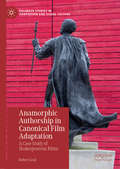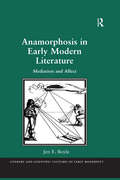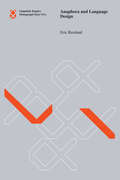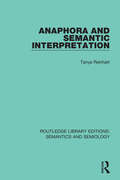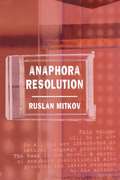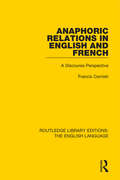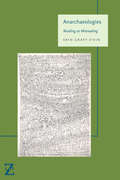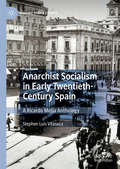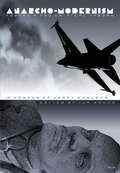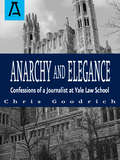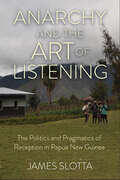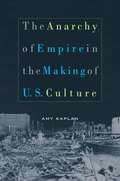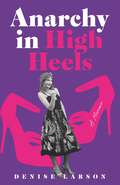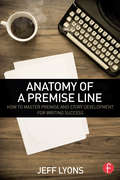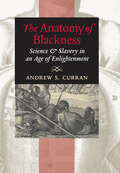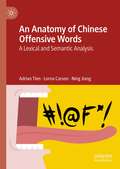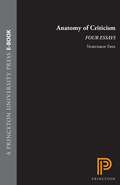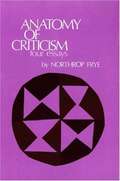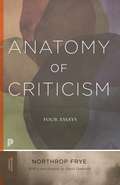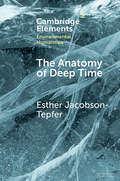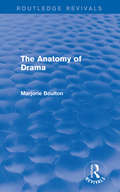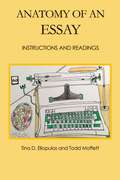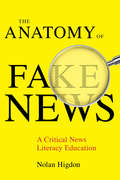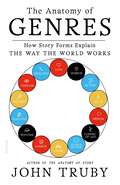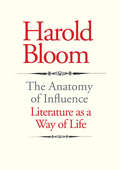- Table View
- List View
Anamorphic Authorship in Canonical Film Adaptation: A Case Study of Shakespearean Films (Palgrave Studies in Adaptation and Visual Culture)
by Robert GealThis book develops a new approach for the study of films adapted from canonical ‘originals’ such as Shakespeare’s plays. Departing from the current consensus that adaptation is a heightened example of how all texts inform and are informed by other texts, this book instead argues that film adaptations of canonical works extend cinema’s inherent mystification and concealment of its own artifice. Film adaptation consistently manipulates and obfuscates its traces of ‘original’ authorial enunciation, and oscillates between overtly authored articulation and seemingly un-authored unfolding. To analyse this process, the book moves from a dialogic to a psychoanalytic poststructuralist account of film adaptations of Shakespeare’s plays. The differences between these rival approaches to adaptation are explored in depth in the first part of the book, while the second part constructs a taxonomy of the various ways in which authorial signs are simultaneously foregrounded and concealed in adaptation’s anamorphic drama of authorship.
Anamorphosis in Early Modern Literature: Mediation and Affect (Literary and Scientific Cultures of Early Modernity)
by Jen E. BoyleAnamorphosis in Early Modern Literature explores the prevalence of anamorphic perspective in the seventeenth and eighteenth centuries in England. Jen Boyle investigates how anamorphic media flourished in early modern England as an interactive technology and mode of affect in public interactive art, city and garden design, and as a theory and figure in literature, political theory and natural and experimental philosophy. Anamorphic mediation, Boyle brings to light, provided Milton, Margaret Cavendish, and Daniel Defoe, among others, with a powerful techno-imaginary for traversing through projective, virtual experience. Drawing on extensive archival research related to the genre of "practical perspective" in early modern Europe, Boyle offers a scholarly consideration of anamorphic perspective (its technical means, performances, and embodied practices) as an interactive aesthetics and cultural imaginary. Ultimately, Boyle demonstrates how perspective media inflected a diverse set of knowledges and performances related to embodiment, affect, and collective consciousness.
Anaphora and Language Design (Linguistic Inquiry Monographs #62)
by Eric ReulandA study on anaphoric dependencies that derives the conditions on anaphora in natural language from the design properties of the language system.Pronouns and anaphors (including reflexives such as himself and herself) may or must depend on antecedents for their interpretation. These dependencies are subject to conditions that prima facie show substantial crosslinguistic variation. In this monograph, Eric Reuland presents a theory of how these anaphoric dependencies are represented in natural language in a way that does justice to the the variation one finds across languages. He explains the conditions on these dependencies in terms of elementary properties of the computational system of natural language. He shows that the encoding of anaphoric dependencies makes use of components of the language system that all reflect different cognitive capacities; thus the empirical research he reports on offers insights into the design of the language system. Reuland&’s account reduces the conditions on binding to independent properties of the grammar, none of which is specific to binding. He offers a principled account of the roles of the lexicon, syntax, semantics, and the discourse component in the encoding of anaphoric dependencies; a window into the overall organization of the grammar and the roles of linguistic and extralinguistic factors; a new typology of anaphoric expressions; a view of crosslinguistic variation (examining facts in a range of languages, from English, Dutch, Frisian, German, and Scandinavian languages to Fijian, Georgian, and Malayalam) that shows unity in diversity.
Anaphora and Semantic Interpretation (Routledge Library Editions: Semantics and Semiology #12)
by Tanya ReinhartFirst published in 1983, this book examines anaphora — a central issue in linguistic theory as it lies at the crossroads of several major problems. On the one hand it is believed that the same conditions that govern the interpretation of anaphora also govern syntactic movement rules but on the other, while anaphora is known to interact with various discourse and semantic considerations, it also provides a clear instance of the dependency of the semantic interpretation of sentences upon semantic properties of natural language. This book has two major goals: the first is a comprehensive analysis of sentence-level anaphora that addresses the questions posed above, and the second is an examination of the broader issues of the relations between the structural properties of sentences and their semantic interpretation within the hypotheses of the autonomy of syntax and of interpretative semantics shown by Chomsky.
Anaphora Resolution (Studies in Language and Linguistics)
by Ruslan MitkovTeaching computers to solve language problems is one of the major challengesof natural language processing. There is a large amount of interesting researchdevoted to this field. This book fills an existing gap in the literature with anup-to-date survey of the field, including the author’s own contributions.A number of different fields overlap in anaphora resolution – computationallinguistics, natural language processing (NLP), grammar, semantics, pragmatics,discourse analysis and artificial intelligence. This book begins by introducingbasic notions and terminology, moving onto early research methods andapproaches, recent developments and applications, and future directions.It addresses various issues related to the practical implementation of anaphorasystems, such as rules employed, algorithms implemented or evaluationtechniques used. This is an ideal reference book for students and researchersin this particular area of computational linguistics.Since anaphora resolution is vital for the development of any practical NLPsystem, the book will be of interest to readers from both academia andindustry.
Anaphoric Relations in English and French: A Discourse Perspective (Routledge Library Editions: The English Language #7)
by Francis CornishFirst published in 1986, this book focuses on Anaphoric relations in the English and French languages, a phenomenon that involves a complex interaction between grammar and discourse. Studies of anaphora taking a largely ‘textual’ approach to the subject have tended to underestimate the effect upon its formation of referential and discourse factors, while studies framed within a psycholinguistic and computational perspective have been inclined to minimise the importance of the purely linguistic features connected with anaphora. This volume places the study of anaphora upon a firmer foundation by examining both its nature and functions in discourse, by pinpointing the range of factors relevant to its operation in the two languages under study, and by attempting to relate the textual and interactional perspectives within a more comprehensive framework.
Anarchaeologies: Reading as Misreading (Lit Z)
by Erin Graff ZivinHow do we read after the so-called death of literature? If we are to attend to the proclamations that the representational apparatuses of literature and politics are dead, what aesthetic, ethical, and political possibilities remain for us today? Our critical moment, Graff Zivin argues, demands anarchaeological reading: reading for the blind spots, errors, points of opacity or untranslatability in works of philosophy and art.Rather than applying concepts from philosophy in order to understand or elucidate cultural works, the book exposes works of philosophy, literary theory, narrative, poetry, film, and performance art and activism to one another. Working specifically with art, film, and literature from Argentina (Jorge Luis Borges, Juán José Saer, Ricardo Piglia, César Aira, Albertina Carri, the Internacional Errorista), Graff Zivin allows such thinkers as Levinas, Derrida, Badiou, and Rancière to be inflected by Latin American cultural production. Through these acts of interdiscursive and interdisciplinary (or indisciplinary) exposure, such ethical and political concepts as identification and recognition, decision and event, sovereignty and will, are read as constitutively impossible, erroneous. Rather than weakening either ethics or politics, however, the anarchaeological reading these works stage and demand opens up and radicalizes the possibility of justice.
Anarchist Socialism in Early Twentieth-Century Spain: A Ricardo Mella Anthology (Hispanic Urban Studies)
by Stephen Luis VilasecaAnarchist Socialism in Early 20th Century Spain is the first English translation of and critical introduction to Ideario, a collection of newspaper and journal articles written by Spanish anarchist Ricardo Mella. Given that Mella is virtually unknown to the English-speaking world, this book provides readers access to his extensive body of work about Spain, human nature, and a world increasingly dominated by capitalism. Suitable for both the general public interested in learning more about anarchist ideas and for scholars studying twentieth-century Spain, the three introductory essays help to introduce Mella, ground his work in the context of Spanish anarchism, and draw connections between Mella and the urban in late nineteenth- and early twentieth-century Spain. Stephen Luis Vilaseca’s translation is accessible and engaging.
Anarcho-Modernism
by Ian AngusThis volume is a collection of 38 pieces - essays, poems, extracts - unified by a combination of the playful, primitive aesthetic of literary modernism with the anti-authoritarian, anarchist praxis of radical democratic politics. This bi-polar sensibility permeates the work of Jerry Zaslove, to whom the book is dedicated.
Anarchy and Elegance: Confessions of a Journalist at Yale Law School
by Chris GoodrichIn Anarchy and Elegance Chris Goodrich deconstructs the inner workings of legal education at the nation's most prestigious law school. A former legal reporter, Goodrich - a Yale graduate - attended the law school on a year-long fellowship for journalists, and soon found himself in a mare's nest of conflicting ideas, emotions, and social visions. His class-by-class account, which showed exactly how law students learn to "think like lawyers," highlights the tension between the often-elegant abstractions of law and the messy, anarchic specifics of "real life." (Edmund Burke's alleged view: "Law sharpens the mind by narrowing it.") His initial skepticism about the law's tendency to operate in a self-referential, we-know-best manner is slowly tempered by admiration for its rigorous methods and theoretical good-faith, and results in a book that proves as entertaining as it is informative.Anarchy and Elegance has been called:"[T]he most creative book on law school in recent memory" (John Jay Osborne, author of The Paper Chase) "A perceptive and insightful inside look at one of America's most influential institutions" (Charles A. Reich, former Yale Law professor and author of The Greening of America) "[A] vivid, amusing and thought-provoking description of what it feels like on the [legal] battlefield" (Robert Heilbroner, author of The Wordly Philosophers)"[Essential, cautionary reading for budding lawyers" (Publishers Weekly)."[A] masterful contribution of the literature of reportage" (Magill Book Review)"[A] bull's eye" (The Jerusalem Post).
Anarchy and the Art of Listening: The Politics and Pragmatics of Reception in Papua New Guinea
by James SlottaAnarchy and the Art of Listening is an ethnography of politics as it is practiced on the other side of the spoken word, in the act of listening. James Slotta explores how people in the Yopno Valley of Papua New Guinea cultivate their listening to exercise power, shape their futures, and sustain their communities in the face of ambitious leaders and powerful outside institutions. As in many parts of the global south, missionaries, NGO workers, educators, mining companies, politicians, development experts, and others have sought to transform life in and around the Yopno Valley. But as this book makes clear, people there have not been a passive and pliable audience for these efforts. They have brought their skills as "anarchic listeners" to these encounters, advancing political agendas of their own.To understand political life in the Yopno Valley, we need to look not only at political speech but at the practices that lie on the other side of the word in the act of listening. This, Slotta suggests, is also true well beyond the bounds of the Yopno Valley.
The Anarchy of Empire in the Making of U.S. Culture (Convergences)
by Amy KaplanThe United States has always imagined that its identity as a nation is insulated from violent interventions abroad, as if a line between domestic and foreign affairs could be neatly drawn. Yet this book argues that such a distinction, so obviously impracticable in our own global era, has been illusory at least since the war with Mexico in the mid-nineteenth century and the later wars against Spain, Cuba, and the Philippines. In this book, Amy Kaplan shows how U.S. imperialism--from "Manifest Destiny" to the "American Century"--has profoundly shaped key elements of American culture at home, and how the struggle for power over foreign peoples and places has disrupted the quest for domestic order. The neatly ordered kitchen in Catherine Beecher's household manual may seem remote from the battlefields of Mexico in 1846, just as Mark Twain's Mississippi may seem distant from Honolulu in 1866, or W. E. B. Du Bois's reports of the East St. Louis Race Riot from the colonization of Africa in 1917. But, as this book reveals, such apparently disparate locations are cast into jarring proximity by imperial expansion. In literature, journalism, film, political speeches, and legal documents, Kaplan traces the undeniable connections between American efforts to quell anarchy abroad and the eruption of such anarchy at the heart of the empire.
Anarchy in High Heels: A Memoir
by Denise LarsonAnarchy in High Heels is not a state of dress; it&’s a state of mind.A San Francisco porno theater might be the last place you&’d expect to plant the seed of a feminist troupe, but truth is stranger than fiction.In 1972, access to birth control and a burn-your-bra ethos were leading young women to repudiate their 1950s conservative upbringing and embrace a new liberation. Denise Larson was a timid twenty-four-year-old actress wannabe when, at an after-hours countercultural event, The People&’s Nickelodeon, she accidentally created Les Nickelettes. This banding together of ¬¬like-minded women with an anything-goes spirit unlocked a deeply hidden female humor. For the first time, Denise allowed the suppressed satirical thoughts dancing through her head to come out in the open. Together with Les Nickelettes, which quickly became a brazen women&’s lib troupe, she presented a series of feminist skits, stunts, and musical comedy plays. In 1980, The Bay Guardian described the group as &“nutty, messy, flashy, trashy, and very funny.&”With sisterhood providing the moxie, Denise took on leadership positions not common for women at the time: playwright, stage director, producer, and administrative/artistic director. But, in the end, the most important thing she learned was the power of female friendship.
Anatomy of a Premise Line: How to Master Premise and Story Development for Writing Success
by Jeff LyonsIf a story is going to fail, it will do so first at the premise level. Anatomy of a Premise Line: How to Master Premise and Story Development for Writing Success is the only book of its kind to identify a seven-step development process that can be repeated and applied to any story idea. This process will save you time, money, and potentially months of wasted writing. So whether you are trying to write a feature screenplay, develop a television pilot, or just trying to figure out your next story move as a writer, this book gives you the tools you need to know which ideas are worth pursuing. In addition to the 7-step premise development tool, Anatomy of a Premise Line also presents a premise and idea testing methodology that can be used to test any developed premise line. Customized exercises and worksheets are included to facilitate knowledge transfer, so that by the end of the book, you will have a fully developed premise line, log line, tagline, and a completed premise-testing checklist. Here is some of what you will learn inside: Ways to determine whether or not your story is a good fit for print or screen Case studies and hands-on worksheets to help you learn by participating in the process Tips on how to effectively work through writer’s block A companion website (www.routledge.com/cw/lyons) with additional worksheets, videos, and interactive tools to help you learn the basics of perfecting a killer premise line
The Anatomy of Blackness: Science and Slavery in an Age of Enlightenment
by Andrew S. Curran2012 Outstanding Academic Title, Choice MagazineThis volume examines the Enlightenment-era textualization of the Black African in European thought. Andrew S. Curran rewrites the history of blackness by replicating the practices of eighteenth-century readers. Surveying French and European travelogues, natural histories, works of anatomy, pro- and anti-slavery tracts, philosophical treatises, and literary texts, Curran shows how naturalists and philosophes drew from travel literature to discuss the perceived problem of human blackness within the nascent human sciences, describes how a number of now-forgotten anatomists revolutionized the era’s understanding of black Africans, and charts the shift of the slavery debate from the moral, mercantile, and theological realms toward that of the "black body" itself. In tracing this evolution, he shows how blackness changed from a mere descriptor in earlier periods into a thing to be measured, dissected, handled, and often brutalized. Penetrating and comprehensive, The Anatomy of Blackness shows that, far from being a monolithic idea, eighteenth-century Africanist discourse emerged out of a vigorous, varied dialogue that involved missionaries, slavers, colonists, naturalists, anatomists, philosophers, and Africans themselves.
An Anatomy of Chinese Offensive Words: A Lexical and Semantic Analysis
by Lorna Carson Ning Jiang Adrian TienThis book offers a precise and rigorous analysis of the meanings of offensive words in Chinese. Adopting a semantic and cultural approach, the authors demonstrate how offensive words can and should be systematically researched, documented and accounted for as a valid aspect of any language. The book will be of interest to academics, practitioners and students of sociolinguistics, language and culture, linguistic taboo, Chinese studies and Chinese linguistics.
Anatomy of Criticism: Four Essays
by Northrop FryeStriking out at the conception of criticism as restricted to mere opinion or ritual gesture, Northrop Frye wrote this magisterial work proceeding on the assumption that criticism is a structure of thought and knowledge in its own right. In four brilliant essays on historical, ethical, archetypical, and rhetorical criticism, employing examples of world literature from ancient times to the present, Frye reconceived literary criticism as a total history rather than a linear progression through time.<P> Literature, Frye wrote, is "the place where our imaginations find the ideal that they try to pass on to belief and action, where they find the vision which is the source of both the dignity and the joy of life." And the critical study of literature provides a basic way "to produce, out of the society we have to live in, a vision of the society we want to live in."<P> Harold Bloom contributes a fascinating and highly personal preface that examines Frye's mode of criticism and thought (as opposed to Frye's criticism itself) as being indispensable in the modern literary world.
Anatomy of Criticism: Four Essays
by Northrop FryeNorthrop Frye wrote this work on the assumption that criticism is a structure of thought and knowledge in its own right. In four essays on historical, ethical, archetypal, and rhetorical criticism, Frye reconceives literary criticism as a total history rather than a linear progression through time.
Anatomy of Criticism: Four Essays (Princeton Classics #70)
by Northrop FryeA landmark work of literary criticismNorthrop Frye's Anatomy of Criticism is the magnum opus of one of the most important and influential literary theorists of the twentieth century. Breaking with the practice of close reading of individual texts, Frye seeks to describe a common basis for understanding the full range of literary forms by examining archetypes, genres, poetic language, and the relations among the text, the reader, and society. Using a dazzling array of examples, he argues that understanding "the structure of literature as a total form" also allows us to see the profoundly liberating effect literature can have.
The Anatomy of Deep Time: Rock Art and Landscape in the Altai Mountains of Mongolia (Elements in Environmental Humanities)
by Esther Jacobson-TepferPetroglyphic rock art in three valleys of Mongolia's Altai Mountains reveals the anatomy of deep time at the boundary between Central and North Asia. Inscribed over a period of twelve millennia, its subject matter, styles, and manner of execution reflect the constraints of changing geology, climate, and vegetation. These valleys were created and shaped by ancient glaciers. Analysis of their physical environment, projected from the deep past to the present, begins to explain the rhythm of cultural manifestations: where rock art appears, when it disappears, and why. The material and this remote arena offer an ideal laboratory to study the intersection of prehistoric culture and paleoenvironment.
The Anatomy of Drama (Routledge Revivals)
by Marjorie BoultonThis title, first published in 1960, is intended primarily to increase the understanding of drama among those who do not have easy access to the live theatre and who, therefore, study plays mainly in print. The author’s emphasis is on Shakespeare, but most forms of drama receive some attention. A lucid and lively study of the techniques of plot, dialogue and characterization will help the reader to a deeper appreciated of the problems and successes of the dramatist.
Anatomy Of An Essay: Instructions And Readings
by Tina D. Eliopulos Todd Scott MoffettAnatomy of an Essay: <p> Focuses on Thesis, development and support, organization, and mechanics <p> Provides readings from professional and student writers <p> Promotes critical thinking through research and literary analysis <p> After practicing the lessons in this textbook, students will gain confidence in their own writing skills as they progress through college classes and into their careers.
The Anatomy of Fake News: A Critical News Literacy Education
by Nolan HigdonSince the 2016 U.S. presidential election, concerns about fake news have fostered calls for government regulation and industry intervention to mitigate the influence of false content. These proposals are hindered by a lack of consensus concerning the definition of fake news or its origins. Media scholar Nolan Higdon contends that expanded access to critical media literacy education, grounded in a comprehensive history of fake news, is a more promising solution to these issues. The Anatomy of Fake News offers the first historical examination of fake news that takes as its goal the effective teaching of critical news literacy in the United States. Higdon employs a critical-historical media ecosystems approach to identify the producers, themes, purposes, and influences of fake news. The findings are then incorporated into an invaluable fake news detection kit. This much-needed resource provides a rich history and a promising set of pedagogical strategies for mitigating the pernicious influence of fake news.
The Anatomy of Genres: How Story Forms Explain the Way the World Works
by John TrubyA guide to understanding the major genres of the story world by the legendary writing teacher and author of The Anatomy of Story, John Truby.Most people think genres are simply categories on Netflix or Amazon that provide a helpful guide to making entertainment choices. Most people are wrong. Genre stories aren’t just a small subset of the films, video games, TV shows, and books that people consume. They are the all-stars of the entertainment world, comprising the vast majority of popular stories worldwide. That’s why businesses—movie studios, production companies, video game studios, and publishing houses—buy and sell them. Writers who want to succeed professionally must write the stories these businesses want to buy. Simply put, the storytelling game is won by mastering the structure of genres.The Anatomy of Genres: How Story Forms Explain the Way the World Works is the legendary writing teacher John Truby’s step-by-step guide to understanding and using the basic building blocks of the story world. He details the three ironclad rules of successful genre writing, and analyzes more than a dozen major genres and the essential plot events, or “beats,” that define each of them. As he shows, the ability to combine these beats in the right way is what separates stories that sell from those that don’t. Truby also reveals how a single story can combine elements of different genres, and how the best writers use this technique to craft unforgettable stories that stand out from the crowd. Just as Truby’s first book, The Anatomy of Story, changed the way writers develop stories, The Anatomy of Genres will enhance their quality and expand the impact they have on the world.
The Anatomy of Influence: Literature as a Way of Life
by Harold Bloom"Literary criticism, as I attempt to practice it," writes Harold Bloom in The Anatomy of Influence, "is in the first place literary, that is to say, personal and passionate." For more than half a century, Bloom has shared his profound knowledge of the written word with students and readers. In this, his most comprehensive and accessible study of influence, Bloom leads us through the labyrinthine paths which link the writers and critics who have informed and inspired him for so many years. The result is "a critical self-portrait," a sustained meditation on a life lived with and through the great works of the Western canon:Why has influence been my lifelong obsessive concern? Why have certain writers found me and not others? What is the end of a literary life? Featuring extended analyses of Bloom's most cherished poets--Shakespeare, Whitman, and Crane--as well as inspired appreciations of Emerson, Tennyson, Browning, Yeats, Ashbery, and others, The Anatomy of Influence adapts Bloom's classic work The Anxiety of Influence to show us what great literature is, how it comes to be, and why it matters. Each chapter maps startling new literary connections that suddenly seem inevitable once Bloom has shown us how to listen and to read. A fierce and intimate appreciation of the art of literature on a scale that the author will not again attempt, The Anatomy of Influence follows the sublime works it studies, inspiring the reader with a sense of something ever more about to be.
